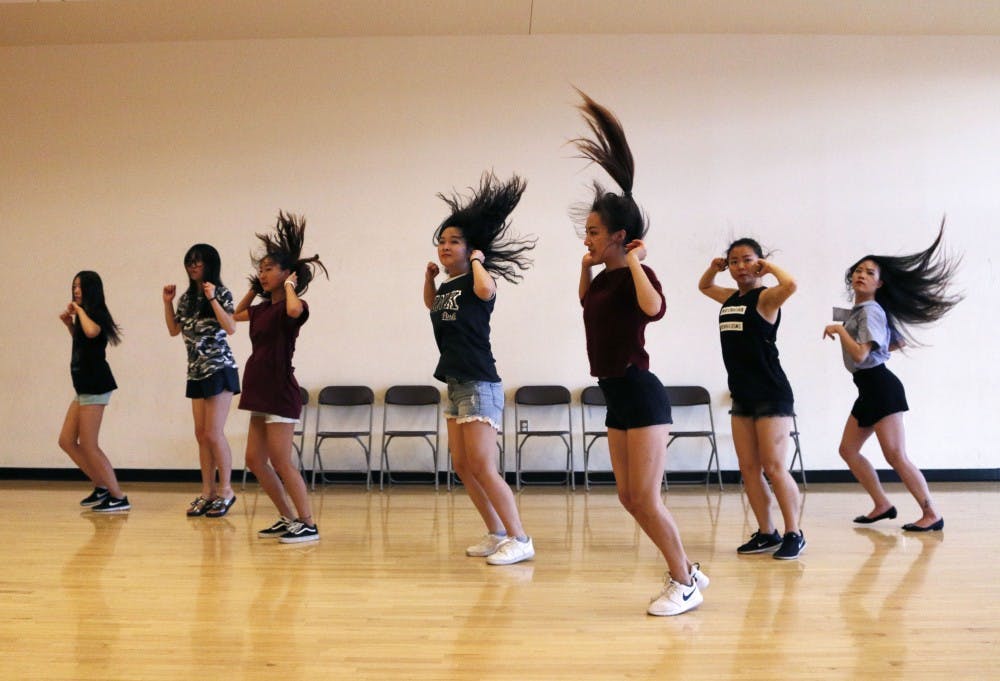Standing behind a light beige building and a canopy of vibrant green trees, approximately 22 ASU students pose either standing up or kneeling down as their performance has come to an end. Sporting a white and black t-shirt with the word KoDE and the South Korean Flag emblem in the middle, the group members smile and giggle at the camera as their picture is snapped.
Minutes before, the members were working together to create a breath-taking performance. Breaking off into sections, each group of about 10 students synchronized as the speakers played. With the vibrant and high-energy beats playing, it appeared each person was enjoying themselves.
Each minute, a transition in music occurred, which allowed a new group to show off what they had practiced weeks before. By the four minute mark, each member could be seen wearing a smile as they transitioned to their final pose.
The scene described is one of many performances done by KoDE.
KoDE, which stands for K-pop Dance Evolution, is a dance club that was founded in October 2013. Since then, it has grown and seen many faces come and go. KoDE focuses on the dance aspect of K-pop and sharing an interest in this genre of music.
The dance club typically meets every Friday evening and learns K-pop choreography. At the end of the semester, the members will perform mashups of multiple songs.
The club’s president, Chieko Kagiyama, is a sophomore studying Japanese. She said KoDE is one of the clubs that bridges an interest with music and dance with cultural awareness.
“With K-pop, I really enjoy the cinematography of the music videos, the dancing and how professional they are," Kagiyama said. "They're professional but also respect each other. I think that’s what I love the most about the K-pop community — that the artists aren’t trying to bash each other, or compete against each other. They’re just trying to show the best of themselves. That’s what I really admire.”
If anyone has a passion for dance but is too shy or intimated by the other dance clubs, Kagiyama said KoDE is a great catalyst for people to get used to experiencing dance and the performance setting.
“I find that people really change after they have their first performance," she said. "A lot of people in KoDE tend to start out being super shy or unsure of how well they will do while performing. But after they perform, it’s just like, you see a sudden change in their attitude. I feel that’s the point where I am like, ‘Ah yes, this semester was worth it.’"
KoDE: Bridging connections through K-pop dance and music from The State Press on Vimeo. Video by Mingson Lau.
One important aspect of the club is that it’s open to everybody and anybody. There is absolutely no need for any dancing experience. Kagiyama said its mission is to bring together K-pop fans.
“It's a place that’s supposed to be a safe place for people to go and enjoy themselves, express their love for K-pop and just have fun," Kagiyama said.
She said one aspect that makes KoDE unique from the other dance clubs is the diversity of the members and the fact that all these different people from different ages and nationalities can come together to enjoy their interest in this music genre.
Along with the diverse members, Kagiyama said KoDE tends to have a friendly image.
“A lot of the dance clubs here on ASU are very serious and very intimidating," she said. "But I think one perk about KoDE is that it’s friendly.”
Kagiyama said new members don't need any previous experience with K-pop or dancing.
“If someone had never heard of K-pop and wanted to know more, I’d tell them, show them a few songs and just let them go have fun with it, because really, K-pop has so many different avenues that it’s just like telling someone to go try out music," she said. "Like there’s country, there's rock, there’s rap, there’s hip-hop, and I think you’ll definitely find at least something to enjoy. So don’t be afraid to try it out.”
K-pop has many definitions, but its basic definition is a type of pop music that began in South Korea.
Makayla Haynes, a freshman art major and independent K-pop cover dancer, said the genre is unique because it's created an international community.
“K-pop is a community of people from all over coming together to enjoy a culture and type of music different from their own," Haynes said.
Cheyenne Gillespie, an undeclared freshman, said she loves the expressive movement of K-pop.
"Dancing is my form of expression," Gillespie said. "When I dance these cover dances, it makes me feel good and brings a feeling of having accomplished something that I may have not thought I could.”
She said it's a good introduction to international culture.
"Once someone gets into the music, it creates an interest in the other things South Korea has to offer,” she said.
Reach the reporter at lcarbaj2@asu.edu or follow @LurissaCarbajal on Twitter.
Like The State Press on Facebook and follow @statepress on Twitter.




